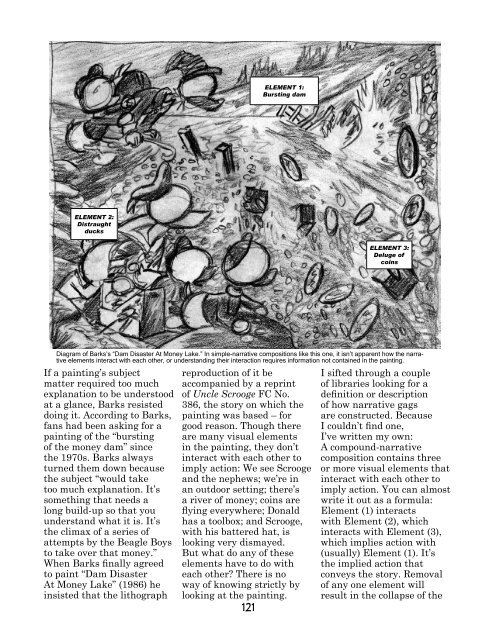Painting Fine-Art Cartoons in Oils - Enchanted Images
Painting Fine-Art Cartoons in Oils - Enchanted Images
Painting Fine-Art Cartoons in Oils - Enchanted Images
Create successful ePaper yourself
Turn your PDF publications into a flip-book with our unique Google optimized e-Paper software.
ELEMENT 2:<br />
Distraught<br />
ducks<br />
Diagram of Barks’s “Dam Disaster At Money Lake.” In simple-narrative compositions like this one, it isn’t apparent how the narrative<br />
elements <strong>in</strong>teract with each other, or understand<strong>in</strong>g their <strong>in</strong>teraction requires <strong>in</strong>formation not conta<strong>in</strong>ed <strong>in</strong> the pa<strong>in</strong>t<strong>in</strong>g.<br />
If a pa<strong>in</strong>t<strong>in</strong>g’s subject<br />
matter required too much<br />
explanation to be understood<br />
at a glance, Barks resisted<br />
do<strong>in</strong>g it. Accord<strong>in</strong>g to Barks,<br />
fans had been ask<strong>in</strong>g for a<br />
pa<strong>in</strong>t<strong>in</strong>g of the “burst<strong>in</strong>g<br />
of the money dam” s<strong>in</strong>ce<br />
the 1970s. Barks always<br />
turned them down because<br />
the subject “would take<br />
too much explanation. It’s<br />
someth<strong>in</strong>g that needs a<br />
long build-up so that you<br />
understand what it is. It’s<br />
the climax of a series of<br />
attempts by the Beagle Boys<br />
to take over that money.”<br />
When Barks f<strong>in</strong>ally agreed<br />
to pa<strong>in</strong>t “Dam Disaster<br />
At Money Lake” (1986) he<br />
<strong>in</strong>sisted that the lithograph<br />
121<br />
ELEMENT 1:<br />
Burst<strong>in</strong>g dam<br />
reproduction of it be<br />
accompanied by a repr<strong>in</strong>t<br />
of Uncle Scrooge FC No.<br />
386, the story on which the<br />
pa<strong>in</strong>t<strong>in</strong>g was based – for<br />
good reason. Though there<br />
are many visual elements<br />
<strong>in</strong> the pa<strong>in</strong>t<strong>in</strong>g, they don’t<br />
<strong>in</strong>teract with each other to<br />
imply action: We see Scrooge<br />
and the nephews; we’re <strong>in</strong><br />
an outdoor sett<strong>in</strong>g; there’s<br />
a river of money; co<strong>in</strong>s are<br />
fly<strong>in</strong>g everywhere; Donald<br />
has a toolbox; and Scrooge,<br />
with his battered hat, is<br />
look<strong>in</strong>g very dismayed.<br />
But what do any of these<br />
elements have to do with<br />
each other? There is no<br />
way of know<strong>in</strong>g strictly by<br />
look<strong>in</strong>g at the pa<strong>in</strong>t<strong>in</strong>g.<br />
ELEMENT 3:<br />
Deluge of<br />
co<strong>in</strong>s<br />
I sifted through a couple<br />
of libraries look<strong>in</strong>g for a<br />
def<strong>in</strong>ition or description<br />
of how narrative gags<br />
are constructed. Because<br />
I couldn’t f<strong>in</strong>d one,<br />
I’ve written my own:<br />
A compound-narrative<br />
composition conta<strong>in</strong>s three<br />
or more visual elements that<br />
<strong>in</strong>teract with each other to<br />
imply action. You can almost<br />
write it out as a formula:<br />
Element (1) <strong>in</strong>teracts<br />
with Element (2), which<br />
<strong>in</strong>teracts with Element (3),<br />
which implies action with<br />
(usually) Element (1). It’s<br />
the implied action that<br />
conveys the story. Removal<br />
of any one element will<br />
result <strong>in</strong> the collapse of the


